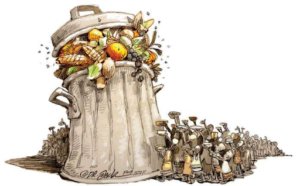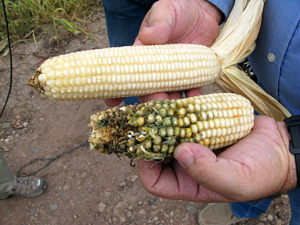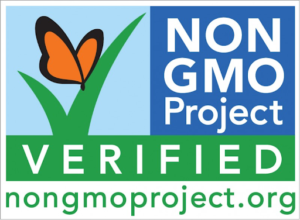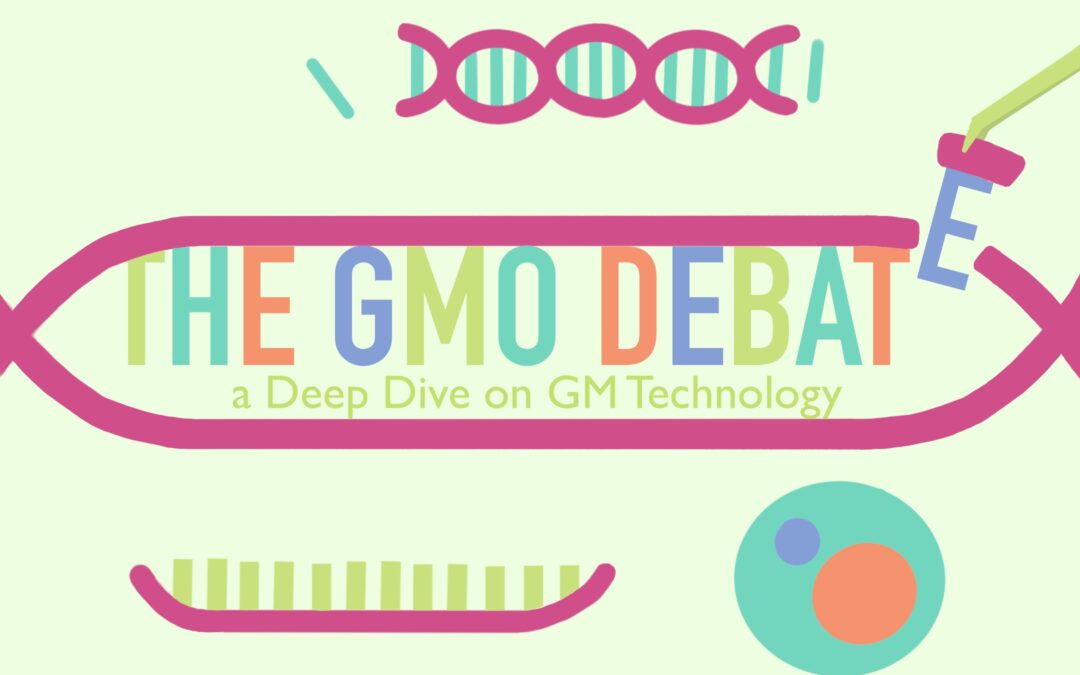Author: Jen Liu
Editor: Connor Fraser
Graphic Designer: Emily Sheng
Publisher: Rayna Almas
Introduction
GMOs or genetically-modified organisms are living things that have had their genetics altered to reflect different traits. The process of genetically engineering these organisms involves slicing and inserting new strands of genetic material for the desired characteristic, which results in a variety of different organisms that cannot be found in nature or made through traditional crossbreeding methods. This piece will provide a detailed look into the world of GMOs, its critics, advocates, producers, and the real-world environmental and human health impacts.
 A Quick Timeline On The Advent of GMOs
A Quick Timeline On The Advent of GMOs
1940 was when humans first discovered that it was possible to alter genetic material. Plant breeders were the first to use radiation or chemicals to change an organism’s DNA at random. However, it is important to note that GM produce was not formally introduced until the 1990s. (Fun Fact: the first piece of GM produce was a tomato.)
Where GMOs Are Used Today
One of the largest uses of genetic modification today is in the food industry. The concern of genetically-modified organisms comes from their effects on the environment and worries about safety for human consumption. Most of the issues surrounding the two topics heavily center around the for-profit companies backing these so-called “scientific studies”. Today genetically-modified crops are mainly averted to animal feed, which effects are just one step away from human consumption. Not to mention that GMOs are found in 75% of processed foods. It may not be fresh produce but that does not mean that we aren’t consuming excessive amounts of it. Because processed food does not have to label whether the ingredients contain GMOs, the issue of safety is often overshadowed.

What We Know About GMOs; The Good And The Bad… But Mostly Bad
Far from conventional belief, genetic engineering is not an extension of natural breeding and has its own set of risks. Proponents of GMOs claim that GM crops are no different from naturally-bred crops in nutritional value, safety, and benefits. This comes as a boldfaced claim at surface level and an outright lie once you begin to examine the technicalities behind genetic modification. Natural breeding can only take place between closely-related life forms. In this process, all the genetic material is passed down directly. Genetic modification by contrast is artificially induced within a laboratory where there is a transfer of genetic material between unrelated or distantly-related organisms. It is effectively a crude, imprecise and inefficient method that is no riskier than mutation breeding (A process in which organisms with mutated strands are randomly bred together to achieve mutation).
Leading to the next point, studies show GM foods can be toxic allergenic or have unintended nutritional changes. In the transformation process, mutagenic effects can disrupt or alter the gene structure and cause changes in the composition of the gene resulting in new toxins/allergens or distorted nutritional imbalance. For example, the Bt toxin in genetically-modified insecticidal (GM crops that are modified to be immune to insecticide) crops can be allergenic or even toxic to some. Glyphosate residuals are found in herbicide-immune GM Roundup Ready crops due to overuse of the herbicide once the weeds build up a resistance. It is known that glyphosate is a known probable carcinogen for humans. Toxicity has been shown to be abundant in animal test trials, causing organ damage and various biological abnormalities (e.g. enlarged lymph nodes, organ aging, higher density of uterine lining, etc.).
GM foods are not strictly tested for safety and never have been. The truth is, the only testing that these products undergo is when they are made and after that, there is minimal regulation stopping them from entering the hands of consumers. The limited amount of independent studies that have been conducted on GM foods are littered with conflicts of interest and the threat of litigation. Long-term studies are even harder to come by, securing funding let alone the grant from proprietary companies to use their seeds in research is even rarer. GM seeds are patented so they cannot be used in research unless permission is granted but access is permitted on a massive caveat. Proprietary companies will not give you access unless you sign a document promising that you will not conduct research, defeating the whole purpose of requesting permission in the first place. From the get go, safety testing should not be left to independent researchers after a product has been released into the market, let alone be blocked from further testing.

Why GMOs Aren’t The Miracle Solution To Solving World Hunger Or Global Demand
Most notably the biggest advocating factor for GM foods is the claim of solving world hunger, even managing Earth’s growing population. For that to be true GM crops would have to outyield conventional crops on an unimaginable magnitude. But the reality is that there is no factual support for these claims. GM crops are no better than traditional methods of production if not worse, there are no GM crops that are more impervious to poor soil quality or tough climate. Most if not all are engineered for herbicide immunity or to contain some form of pesticides, occasionally both. Soy and corn, the two most-produced GM crops mainly go into animal feed, biofuel, and processed food. Proponents of the industry love peddling the narrative of a sustainable miracle solution in GM foods but it could not be further from the truth. When looking for information on population growth you’ll often come across statistics that state the population will grow to around 10 billion by 2050. By only looking at the population growth there is an illusion of insufficient resources simply because 10 billion is such a daunting number. What is failed to mention is that we currently already produce more than enough food for every person on the planet and have the current means of feeding 12 billion people (UN Food & Agriculture Organization). GMO advocates say that the technology is essential to feed the world. Yet the world already produces enough food for the expected population of the world by 2050. Hunger and food insecurity are not a production issue but one of social justice and wealth inequality.


Big Farming’s Influence: What It Means For Local Produce, Who Is Pushing For GMOs
A handful of companies that control GM seeds are able to use predatory practices to increase the market share of their products. Ex. Monsanto (who own 60% of the industry) who makes the widely-used weed killer RoundUp, and developed crops that have a resistance to their own brand of herbicide. In countries like Mexico and Paraguay that grow the majority of North American produce, native crop farmers are being sabotaged to purchase only their seed and herbicide. It is a fact that when GMO seeds cross-pollinate with native seed crops it contaminates and turns them into so-called “monster crops”. So if one local farmer uses Monsanto’s seeds and it is blown onto a nearby farm that doesn’t use the seed it could contaminate a large portion of their annual yield. This strategy forcefully converts the local farmers in the area to exclusively plant Roundup-ready crops further adding to their monopoly over food production. RoundUp has been in over 100 litigations with the most recent one having a settlement of a little over 9 billion dollars because it caused Non-Hodgkin Lymphoma (cancer) and is a carcinogen not labeled as such. These GM crops are being drowned in RoundUp. Monsanto has sued in retaliation against the farmers that have made complaints about their GM seeds’ predatory business monopoly. Monsanto has filed 144 lawsuits against farms for “violations against their patented seed technology”, And it has brought up to over 700 charges in an attempt to scare them out of legal action.

Canada On GM Foods
In Canada, the regulatory body for all GMOs entering the Canadian marketplace is Health Canada, which states that it is unaware of any evidence that suggests GM foods are unsafe for us to eat. This is a daunting notion to promote since nearly ⅓ of Canadian food now tests positive for glyphosate herbicide residue. 88% of the Canadian public agrees that GMO products should be labeled and yet there is nothing enforcing this sentiment within our regulating bodies. Canada’s own Parliament has voted against the GMO labeling bill on two separate occasions. It would be ignorant to deny the amount of lobbying that occurs in Canada’s agricultural industry and the profound amount of influence these large corporations have on our government. It may seem perfectly reasonable to provide consumers with the basic information on how their food is produced, but that isn’t what these companies have in mind. Note that our only regulatory body on GMOs does not conduct their own research into new products that come into the market but instead relies on the companies themselves to provide studies. The qualifications of such are abysmal and peer review is optional. Furthermore, this evaluation process is far from transparent; any information in the evaluation is kept confidential and hidden from consumers, farmers, and independent researchers.

Is The GMO Label Safe/Reliable/Trustworthy?
64 countries around the world mandate labeling GMO food, and some European countries ban them altogether. Canada is not a stranger to the “Non-GMO project verified” label but recent regulations have further reduced the barriers to getting that label onto products. Where Health Canada is the regulatory body, the CFIA (Canadian Food Inspection Agency) is responsible for federal food labeling policies. You might be surprised to find out that the new “Non-GMO project verified” label does not equate to being GMO-free, the key is in the wording (project verified). This infamous label is categorized under voluntary labeling which is not related to the safety of the product. Consumer consensus is decisive in a product’s profitability but when they are not aware or informed of such details in the fine print it can contribute to a gross misinterpretation of the facts surrounding a product. When the majority of the public is under the notion that a product is superior to alternatives, it guilts them into spending more on an unrelated aspect rather than the product they paid for. It is a poor reflection on our regulatory bodies when consumers have to conduct strenuous research into necessities that are a part of our everyday life.
Conclusion:
For more information, I highly recommend picking up or viewing the publicly available examination done by the Earth Open Source organization titled GMO Myths and Truths. It is a well-articulated and thorough look into the topic and takes a far more transparent and scientific stance than most articles you can find online. I have linked it as the first reference on the list for your convenience.
With how deeply corporate greed and corruption have privatized the industry of agriculture, the current state of GM technology has no place in our society. Before supporting this narrative of saving the world we should perhaps look at the food surplus we currently have and are wasting. It is hard to say when it will ever be cleansed of its problematic connections and haphazard production. But when it is being used as a tool to sabotage and corner small production farms to buy certain companies’ products we simply cannot let it continue. With all of the propaganda that these companies pump out, it may be hard to come to a conclusion around GM foods, but a healthy amount of skepticism is always a good rule of thumb.
References:
Antoniou, M., Robinson, C., Fagan, J.. 2012. GMO Myths and Truths: An Evidence-based Examination of the Claims Made for the Safety and Efficacy of Genetically Modified Crops. London, UK: Earth Open Source. Retrieved November 29, 2021, from http://earthopensource.org/wordpress/downloads/GMO-Myths-and-Truths-edition2.pdf.
Center for Food Safety and Applied Nutrition, F. D. A. (2021). Science and history of gmos and other food modification processes. U.S. Food and Drug Administration. Retrieved November 29, 2021, from https://www.fda.gov/food/agricultural-biotechnology/science-and-history-gmos-and-other-food-modification-processes.
Giroux, A. (2019). Canada doesn’t label GMO Foods even though 88% of us say we should. CBCnews. Retrieved November 29, 2021, from https://www.cbc.ca/cbcdocspov/features/canada-doesnt-label-gmo-foods-even-though-88-of-us-say-we-should.
Giroux, A. (2019). GMOs are in our food, but we aren’t being told about them. CBCnews. Retrieved November 29, 2021, from https://www.cbc.ca/cbcdocspov/features/gmos-are-in-our-food-but-we-arent-being-told-about-them.
Government of Canada, C. F. I. A. (2021, June 11). Labeling of genetically engineered foods in Canada. Canadian Food Inspection Agency. Retrieved November 29, 2021, from https://inspection.canada.ca/food-label-requirements/labelling/consumers/genetically-engineered-foods/eng/1333373177199/1333373638071.

